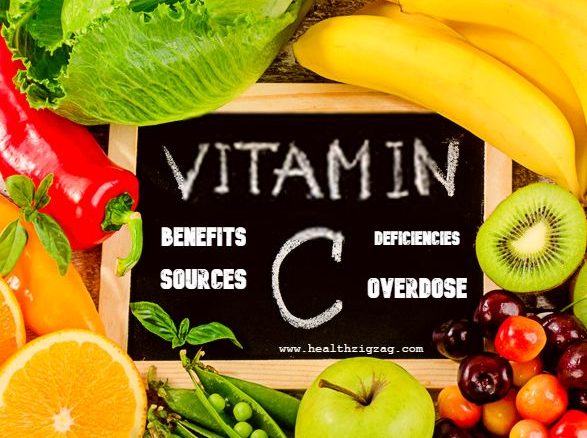
Contents
Ascorbic acid or vitamin C is a water-soluble vitamin. It is a non-caloric organic substance, essential to our metabolism and not produced by our body [1].
It is soluble in water (water-soluble ) and, as a result, is rapidly eliminated in the urine [2].
Daily consumption of this water-soluble vitamin is necessary to maintain the quantity necessary for the proper functioning of the body.
Read Also: 10 Foods That Are Rich In Vitamin C
Read Also: Six Essential Nutrients Which Are Important For Your Body
What is it for?
Ascorbic acid is a powerful antioxidant. It scavenges free radicals produced by the body in case of external aggression (pollution, stress, radiation, tobacco, alcohol, chemicals) or internal (chemical reactions of synthesis or degradation certain molecules, inflammation, cellular respiration).
These free radicals, also known as reactive oxygen species (ROS), are unstable and highly reactive derivatives of oxygen. They are responsible for various disturbances (oxidative stress) but also have a positive role (communication between cells, the functioning of certain cells and enzymes).
Our body has endogenous defense systems (specific to our body). It can also use exogenous systems to combat the harmful effects of oxidative stress. Vitamins C and E are the most important carotenoids. Polyphenols also participate in the defense.
Read Also: What do you need to know about vitamin A?
Vitamin C regenerates vitamin E and vice versa [3]. This major anti-oxidant role may explain the positive role of vitamin C in the prevention of cardiovascular diseases, cataracts, certain cancers, and infections.
By involving in collagen synthesis, vitamin C has a role in maintaining tissue structure. It participates in the synthesis of catecholamines and certain neuroendocrine hormones. It facilitates the transformation of cholesterol and helps with liver detoxification. Ascorbic acid or vitamin C also promotes the absorption of iron in the intestine. It inhibits the synthesis of nitrosamines, carcinogenic substances.
Read Also: Vitamin K: Description, Food Sources, Deficiency, Precautions, Interactions
Absorption and metabolism
Absorption begins at the mucous membrane of the pharynx (at the back of the throat) and continues into the first part of the small intestine.
The mode of passage through the wall of the intestine is a function of the amount of vitamin C ingested. The passage is active (that is to say requiring energy) in case of low doses and passive in case of large amounts ingested. In the same way, the rate of absorption decreases with the increase of the doses present in the intestine.
Three-quarters of the Ascorbic acid present in the plasma is in free form. The remaining quarter-bound to proteins. It is especially present in the brain, the eyes, the liver, the pituitary, and the adrenals. It essentially eliminated by the kidneys.
Read Also: 10 Proven Ways To Relieve The Pain Of Kidney Stones
Read Also: How To Use Aloe Vera To Treat Constipation
Requirements and sources of intake
Many vegetables and fruits are sources of vitamin C.
Needs have been determined to prevent the onset of scurvy, a disease directly linked to Ascorbic acid deficiency [4]. The concentration of 60 micrograms per day of vitamin C prevents this disease and sufficient for its various functions.
The needs increased in sportsmen, in case of stress (infections, after surgery) and in certain pathologies such as hyperthyroidism which causes an increase in the expenses of the body.
Recommended dietary intakes are 110 milligrams of vitamin C per day, starting at age 13, regardless of sex. They increased to 120 over 60 and in case of pregnancy or breastfeeding. The smoker must also pay particular attention to regular consumption (some recommend 150 mg/day in case of heavy smoking) [5].
Read Also: Vitamin B Foods Which Are Important For Your Health
These inputs largely covered by consuming three fruits or vegetables a day. However, Ascorbic acid is very sensitive to storage mode and exposure to oxygen.
Thus, high temperature and prolonged cooking, freezing and long-term sterilization inactivate vitamin C. The rate in fruits and vegetables is maximum at the point of maturity and then gradually decreases. The bleaching would inactivate the enzymes responsible for the degradation of vitamin C. Thus, raw consumption should be preferred when possible or steamed in other cases [6].
Vegetables and fruits which are full of vitamin C
The peppers and cabbage (Broccoli, Brussels, Cauliflower ) are the most vegetables rich in vitamin C. Citrus fruits (lemon, orange, grapefruit, tangerine ), the kiwi, the strawberries, mangoes, papayas, tomatoes bring vitamin C and many phytonutrients.
Read Also: 50 Foods That Are Super Healthy
The parsley, of easy pot culture, is a source of ascorbic acid.
The exotic berries: Goji berries, acerola, sea buckthorn, rose hips, recently available, are up to ten times higher in vitamin C than the foods described above. This wide and varied choice allows us to easily favor the natural forms of vitamin C.
Deficiencies and overdose
Overdose does not exist but vitamin C deficiencies characterized by scurvy.
The scurvy ‘s disease linked to a deficiency of vitamin C.
It is characterized at an early stage by bleeding gums, muscle aches, fatigue, fever and, at an advanced stage, anemia due to extensive subcutaneous hemorrhages and cardiac disorders that may lead to death.
Overdose does not exist, even for consumption exceeding 10 grams per day. Ascorbic acid eliminated in the urine when its plasma concentration reaches or exceeds 12 mg / L. Metabolites such as Diketogulonic acid and oxalate found in the urine.




